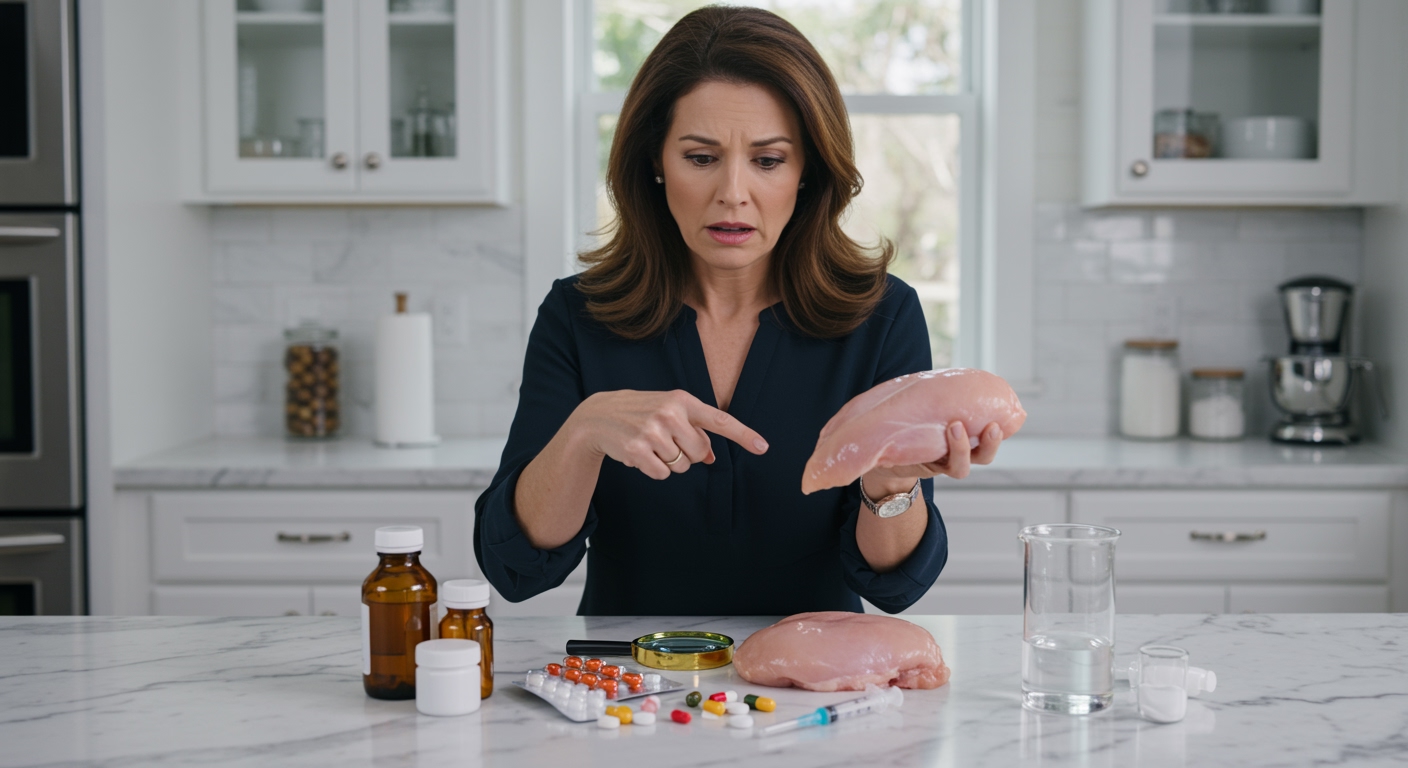✪ Key Takeaway: Modern chicken contains antibiotic residues and chemical treatments that often exceed levels found in prescription medicines.
Introduction
You walk into the grocery store thinking chicken breast is a healthy protein choice.
But what if I told you that piece of chicken contains more chemical residues than many prescription drugs sitting in your medicine cabinet?
Hi, I’m Abdur, your nutrition coach and today I’m going to expose the shocking truth about the chemical cocktail hiding in your everyday chicken breast.
What Chemicals Are Actually In Your Chicken?
Modern poultry farming relies heavily on antibiotic treatments that remain in the meat long after processing.
Farmers inject chickens with antibiotics like tetracycline, penicillin, and sulfonamides to prevent disease in overcrowded conditions.
These antibiotics accumulate in muscle tissue and fat, creating residue levels that persist through cooking and digestion.
Research shows that chicken meat contains detectable levels of multiple antibiotic compounds simultaneously.
The chemical processing doesn’t stop there.
Poultry facilities use chlorine washes, sodium phosphates, and other chemical treatments during processing to extend shelf life and improve appearance.
Your chicken breast becomes a complex mixture of synthetic compounds that your body must process and eliminate.
✪ Fact: A single chicken breast can contain residues from up to 12 different antibiotic compounds.
How Do These Chemical Levels Compare To Medicine?
The comparison between chicken chemicals and medicine reveals a disturbing reality.
A typical prescription antibiotic contains one active compound in a controlled dose.
Your chicken breast contains multiple antibiotic residues plus processing chemicals in unregulated combinations.
Studies show that some chicken samples contain antibiotic residues at levels approaching therapeutic doses found in human medications.
The key difference is that medicines undergo strict testing for safety and efficacy.
Chicken chemical residues receive minimal testing for cumulative effects or long-term health impacts.
When you consume chicken regularly, you’re essentially taking multiple micro-doses of various pharmaceutical compounds without medical supervision.
✪ Note: Unlike prescribed medicine, chicken chemical exposure happens without your knowledge or consent.
Why Do Farmers Use So Many Chemicals?
The modern poultry industry operates on a factory farming model that prioritizes speed and profit over animal welfare.
Chickens grow from hatchling to market weight in just 6-8 weeks, compared to 16 weeks in traditional farming.
This rapid growth requires growth promoters and antibiotics to prevent the health problems that naturally occur with accelerated development.
Overcrowded conditions create perfect breeding grounds for disease, making preventive antibiotics seem necessary for survival.
Farmers also use chemicals to improve meat appearance and extend shelf life for better market appeal.
The economic pressure to produce cheap chicken drives the use of every available chemical enhancement that regulations allow.
Unfortunately, these farming practices treat chickens as production units rather than living animals, resulting in chemical-laden meat products.
✪ Pro Tip: Factory farming conditions make chemical use almost inevitable for commercial viability.
What Health Risks Do These Chemicals Create?
Regular consumption of chemically-treated chicken poses several significant health risks.
Antibiotic resistance develops when your body’s bacteria adapt to constant low-level antibiotic exposure.
This resistance makes future infections harder to treat with standard medications.
The chemical cocktail in chicken can disrupt your gut microbiome, killing beneficial bacteria that support digestion and immunity.
Processing chemicals like sodium phosphates contribute to inflammation and may worsen conditions like arthritis and heart disease.
Some studies link regular consumption of chemically-treated meat to increased cancer risk and hormonal disruption.
Children face particular risks because their developing systems are more sensitive to chemical exposure than adult bodies.
✪ Fact: Antibiotic-resistant infections kill more than 35,000 Americans annually according to CDC data.
How Can You Choose Safer Chicken Options?
Finding cleaner chicken requires understanding labels and making informed purchasing decisions.
Look for organic certification, which prohibits the use of antibiotics, growth hormones, and synthetic chemicals.
Labels reading “no antibiotics ever” or “raised without antibiotics” indicate better farming practices.
Pasture-raised chicken comes from farms that allow birds natural movement and feeding, reducing the need for chemical interventions.
Local farmers markets often sell chicken from smaller operations that use fewer chemicals than industrial farms.
Consider reducing your overall chicken consumption and choosing higher-quality options less frequently rather than cheap chicken daily.
Always read ingredient lists on processed chicken products, as these contain even more chemical additives than fresh meat.
✪ Pro Tip: Spending more on cleaner chicken saves money on future healthcare costs from chemical exposure.
The Bottom Line
Your chicken breast contains a complex mixture of antibiotics and processing chemicals that often exceeds the chemical content of prescription medicines.
When your food contains more chemicals than your medicine cabinet, it’s time to question what you’re really eating.
I’d love to hear your thoughts about this information and any questions you might have about choosing cleaner protein sources in the comments below.
References
At NutritionCrown, we use quality and credible sources to ensure our content is accurate and trustworthy. Below are the sources referenced in creating this article:
- PMC: Antibiotic Use in Poultry Production and Its Effects on Bacterial Resistance
- The Humane League: Do Growth Hormones in Chickens Affect Humans and Increase HGH
- USDA: Restrictions on Antibiotic Use for Production Purposes in U.S. Livestock Industries
- PMC: Antibiotic Residues in Food Animals: Causes and Consequences

